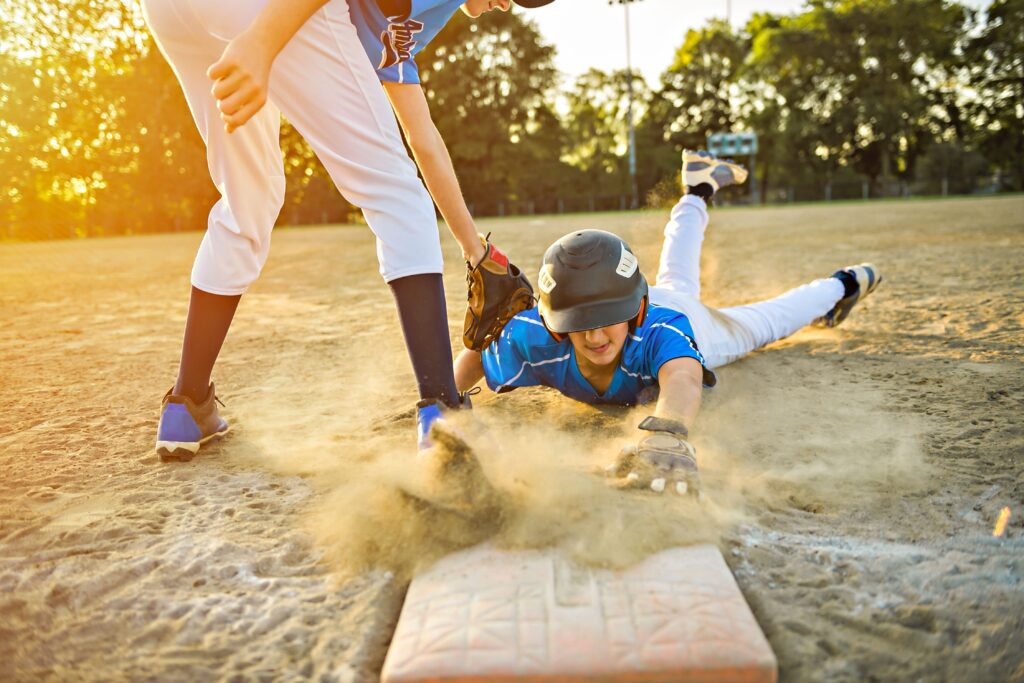When you're dealing with a sports injury, understanding your treatment options is vital for a swift recovery. From physical therapy that builds strength to chiropractic care that realigns your body, various methods can help you regain your performance. You might also consider complementary therapies like massage and acupuncture, which target pain and inflammation. But what's the best combination for your specific situation? Exploring these treatments can reveal surprising insights that could change your approach to recovery.
Physical Therapy
Physical therapy is vital for anyone recovering from a sports injury, as it helps you regain strength and mobility. When you've sustained an injury, your body needs targeted rehabilitation to heal properly. A skilled physical therapist will assess your condition and design a personalized program tailored to your specific needs. This approach guarantees that you're not just recovering but also minimizing the risk of future injuries.
During your sessions, you'll engage in various exercises aimed at restoring range of motion, improving flexibility, and building strength. These exercises are essential because they help you re-establish the muscle coordination necessary for your sport. You'll also learn techniques to manage pain and inflammation, which can be particularly beneficial in the early stages of recovery.
In addition to exercises, your therapist may use modalities like ice, heat, or electrical stimulation to enhance your recovery. These treatments can speed up healing and alleviate discomfort, allowing you to focus on rehabilitation without being sidelined by pain.
As you progress, your therapist will adapt your program to increase intensity, making sure you're challenged appropriately while still remaining safe. Regular check-ins will help track your progress and make necessary adjustments.
Ultimately, committing to physical therapy can make a significant difference in your recovery journey. It not only aids in healing but also empowers you to return to your sport stronger than before, ready to tackle challenges with confidence.
Massage Therapy
Massage therapy offers significant benefits for sports injury recovery, helping to relieve pain and improve circulation.
By using various techniques, you can enhance your healing process and regain mobility more quickly.
Let's explore how these methods can support your journey back to peak performance.
Benefits of Massage Therapy
How can massage therapy enhance your recovery from sports injuries? First, it increases blood circulation, which delivers essential nutrients and oxygen to damaged tissues. When you're injured, this process is essential for healing.
You'll notice that improved circulation can reduce inflammation and swelling, helping you feel better faster.
Additionally, massage therapy helps to alleviate muscle tension and spasms. By loosening tight muscles, you'll regain mobility and flexibility more quickly, allowing you to return to your sport sooner.
It can also help prevent further injuries by promoting proper muscle alignment and balance.
Furthermore, the psychological benefits shouldn't be overlooked. Massage therapy can reduce stress and anxiety, helping you maintain a positive mindset during your recovery.
When you feel more relaxed, your body can focus on healing, which is critical for your overall recovery process.
Lastly, regular massage sessions can improve your overall performance by enhancing your body awareness and helping you understand how to move more efficiently.
Incorporating massage therapy into your recovery routine can make a significant difference, enabling you to bounce back stronger and more resilient than ever.
Techniques for Injury Recovery
When recovering from a sports injury, utilizing various massage therapy techniques can greatly enhance your healing process. One effective technique is deep tissue massage, which targets the deeper layers of muscle and connective tissue. This helps break down scar tissue and alleviates chronic tension, aiding in your recovery.
Another technique is sports massage, specifically designed for athletes. It focuses on areas of the body that are overused and stressed from repetitive movements, promoting flexibility and reducing soreness.
You might find trigger point therapy beneficial too, as it addresses specific tight spots in your muscles, relieving referred pain and improving overall function.
Don't overlook the benefits of myofascial release. This technique gently stretches and loosens the fascia, which can become tight after an injury, enhancing blood flow and promoting healing.
Remember to communicate with your therapist about your injury's specifics and any discomfort during the session.
Regular sessions can greatly contribute to your overall recovery, helping you regain strength and mobility. Incorporating these massage techniques into your rehabilitation plan can make a noticeable difference in how quickly and effectively you bounce back.
Cryotherapy
While you might be familiar with various sports injury treatments, cryotherapy stands out as a popular method for reducing inflammation and speeding up recovery. This technique involves exposing your body to extremely cold temperatures for a short duration, usually around two to three minutes. It's believed that this exposure constricts blood vessels, which helps decrease swelling and pain in injured areas.
When you undergo cryotherapy, your body responds by directing blood flow to your core, which can lead to improved circulation once you return to normal temperature. This process not only promotes healing but also helps flush out toxins that may have built up in your muscles. Many athletes swear by cryotherapy for its quick results and minimal downtime.
You can choose from whole-body cryotherapy chambers or localized treatments targeting specific areas. Whole-body sessions involve stepping into a chamber that cools your entire body, while localized cryotherapy uses ice packs or machines to treat specific injuries.
Regardless of the method you choose, the cold therapy can provide a revitalizing and rejuvenating experience. It's essential to consult with a healthcare professional before trying cryotherapy, especially if you have pre-existing conditions. They can help determine if it's suitable for your specific injury.
Many athletes find that incorporating cryotherapy into their recovery routine enhances their performance, allowing them to get back to their favorite sports faster and with less pain.
Acupuncture
Acupuncture can be a game changer for your sports injuries, helping with pain reduction and speeding up your recovery.
By stimulating specific points on your body, it encourages healing and alleviates discomfort.
If you're looking for a complementary treatment, acupuncture might just be what you need.
Pain Reduction Techniques
Often overlooked in traditional sports injury treatments, acupuncture offers a unique approach to pain reduction that many athletes have found effective. This ancient technique involves inserting thin needles into specific points on your body, targeting areas where you experience pain or discomfort. By stimulating these points, acupuncture can help release endorphins, your body's natural painkillers, and promote blood flow to the injured area.
When you're dealing with the aftermath of a sports injury, you mightn't want to rely solely on medication. Acupuncture provides a drug-free alternative that can complement your healing process. Many athletes report reduced pain and improved flexibility following treatment, allowing them to return to their sport sooner.
You don't have to feel apprehensive about trying acupuncture; many practitioners are trained to work specifically with athletes. During your sessions, you can discuss your specific injury and develop a tailored treatment plan.
Remember that consistency is key; regular sessions can enhance your overall results. So, if you're looking for an effective pain reduction technique, consider giving acupuncture a shot—it might just be the relief you've been searching for.
Enhanced Recovery Process
The enhanced recovery process following a sports injury can greatly benefit from acupuncture. This ancient practice not only helps alleviate pain but also promotes healing by improving blood circulation and reducing inflammation.
When you incorporate acupuncture into your recovery routine, you'll likely experience several advantages:
- Pain Relief: Acupuncture can effectively reduce pain levels, allowing you to regain mobility faster.
- Reduced Swelling: The treatment can help decrease inflammation, speeding up the healing process.
- Improved Range of Motion: You'll find that acupuncture enhances flexibility, which is essential for returning to your sport.
- Stress Reduction: The calming effects of acupuncture can help relieve anxiety, making your recovery more manageable.
- Faster Recovery: Overall, acupuncture accelerates the healing process, enabling you to get back to your game sooner.
Chiropractic Care
When it comes to managing sports injuries, chiropractic care stands out as a powerful option. This hands-on approach focuses on realigning your musculoskeletal system, which can alleviate pain, improve mobility, and enhance your overall performance. Chiropractors utilize a variety of techniques, including spinal adjustments, soft tissue therapy, and mobilization methods to target the root cause of your discomfort.
One of the biggest advantages of chiropractic care is its emphasis on natural healing. Instead of relying on medications that might mask pain or lead to side effects, chiropractic adjustments aim to restore proper function to your body. This enhances your body's ability to heal itself, allowing you to return to your favorite sports more quickly and safely.
You might also appreciate how chiropractic care can help prevent future injuries. By addressing biomechanical imbalances, your chiropractor can guide you in strengthening weak areas and improving your posture. This proactive approach not only speeds up recovery but also reduces the risk of recurring injuries, keeping you in the game longer.
Regular visits to a chiropractor can also enhance your athletic performance. By ensuring that your body is aligned and functioning efficiently, you may find that your range of motion improves, and your overall strength increases.
Whether you're a weekend warrior or a professional athlete, chiropractic care can be an integral part of your injury management and prevention strategy, allowing you to enjoy sports with less pain and more confidence.
Ultrasound Therapy
Ultrasound therapy is a valuable tool in the treatment of sports injuries, harnessing sound waves to promote healing and reduce pain. This non-invasive technique penetrates deep into tissues, stimulating blood flow and accelerating recovery.
Whether you're dealing with sprains, strains, or tendonitis, ultrasound therapy can be an effective part of your rehabilitation plan.
Here are some key benefits of ultrasound therapy:
- Pain Relief: It can help alleviate pain by reducing inflammation and promoting tissue healing.
- Increased Blood Flow: Enhanced circulation helps deliver essential nutrients to injured areas, speeding up recovery.
- Reduced Muscle Spasms: The therapy can relax tight muscles, improving overall mobility and comfort.
- Accelerated Tissue Repair: Ultrasound promotes collagen production, which is essential for healing damaged tissues.
- Non-Invasive: It's a safe, painless option that doesn't require medication or surgery.
You'll typically undergo a session where a gel is applied to the skin, and a handheld device emits sound waves over the injured area.
Each session lasts about 5 to 10 minutes and can be done multiple times a week, depending on your injury.
Many athletes find that incorporating ultrasound therapy into their recovery routine enhances their overall progress.
By addressing pain and promoting healing, you'll be back to your favorite activities faster.
If you're considering ultrasound therapy, consult a healthcare professional to determine if it's the right fit for your sports injury recovery plan.
Rest and Recovery
Although many athletes are enthusiastic to jump back into their routines, prioritizing rest and recovery is essential for effective healing. When you experience a sports injury, your body needs time to repair itself. Ignoring the need for rest can prolong your recovery and even lead to further damage.
Start by listening to your body. If you're feeling pain, fatigue, or discomfort, it's a clear sign to take a step back. Implementing rest days into your training schedule isn't a sign of weakness; it's a strategy for long-term success.
Active recovery, which includes low-intensity exercises like walking or gentle stretching, can also promote blood flow and enhance healing without overexerting yourself.
Adequate sleep plays a vital role in recovery too. Aim for 7-9 hours each night to allow your body to regenerate tissues and restore energy levels. Staying hydrated is equally important, as fluids help transport nutrients and flush out toxins, aiding the healing process.
Consider nutrition as part of your recovery strategy. Consuming a balanced diet rich in proteins, vitamins, and minerals will provide the necessary building blocks for tissue repair.
Foods high in omega-3 fatty acids, antioxidants, and lean proteins can greatly support your recovery.
Compression Therapy
Compression therapy can greatly enhance your recovery process by reducing swelling and increasing blood circulation. This treatment involves applying pressure to the affected area, which can help alleviate pain and facilitate healing.
Whether you're dealing with a sprain, strain, or any other sports-related injury, incorporating compression therapy into your routine can make a significant difference.
Here are some benefits of compression therapy:
- Reduces inflammation: Compression helps minimize swelling, allowing your body to heal more effectively.
- Improves circulation: Enhanced blood flow delivers crucial nutrients to your injured tissues, speeding up recovery.
- Supports muscle recovery: Compression garments or wraps help stabilize muscles, preventing excessive movement that could worsen your injury.
- Decreases pain: By applying pressure, compression can numb the area, providing relief from discomfort.
- Boosts performance: Once you're back in action, compression can enhance your performance by reducing muscle fatigue during workouts.
You can choose from various compression methods, such as sleeves, wraps, or specially designed garments.
It's important to find the right fit and level of compression for your specific injury. Always consult with a healthcare professional before starting any new treatment, as they can guide you on the most effective approach for your needs.
Incorporating compression therapy into your recovery plan can be a game-changer, helping you bounce back stronger and faster.
Taping and Bracing
Taping and bracing are essential techniques in sports injury management that can provide stability and support to injured joints and muscles during your recovery. These methods help reduce pain and prevent further injury while you heal. Taping involves using adhesive tape to support and immobilize specific areas, while bracing typically utilizes a structured device to maintain joint alignment and limit movement.
When you tape an injured area, it's important to apply the tape correctly. You'll want to start by cleaning the skin and using a pre-tape adhesive spray if necessary. Choose the right tape—kinesiology tape offers flexibility, while rigid tape provides more support. Make sure to wrap the tape snugly but not too tight, as you don't want to cut off circulation.
Braces come in various designs, catering to different types of injuries. For instance, an ankle brace can stabilize your joint during recovery, while a knee brace can help alleviate pressure on an injured ligament. When selecting a brace, consider the level of support required and your comfort.
Both taping and bracing can enhance your performance by allowing you to participate in sports while minimizing the risk of re-injury. However, it's important to consult a healthcare professional before implementing these techniques, as they can provide personalized recommendations based on your specific injury.
Ultimately, utilizing taping and bracing effectively can be a game-changer in your path to recovery.
Conclusion
Incorporating a mix of treatments can greatly enhance your recovery from sports injuries. Whether you choose physical therapy for strength, massage for relaxation, or cryotherapy to reduce inflammation, each method plays an essential role in your healing process. Don't forget the importance of rest and recovery, as they are critical for your overall well-being. By combining these therapies, you'll be better equipped to get back in the game, feeling stronger and more resilient than ever.



